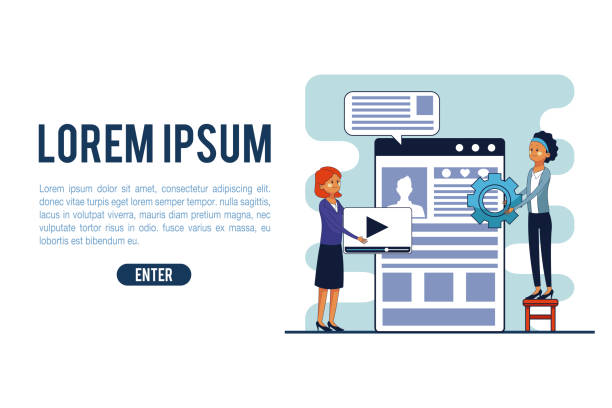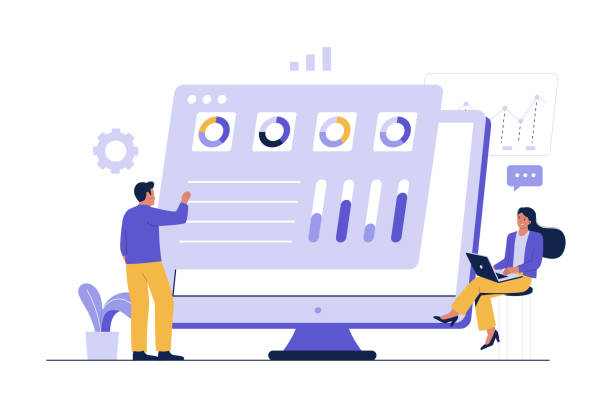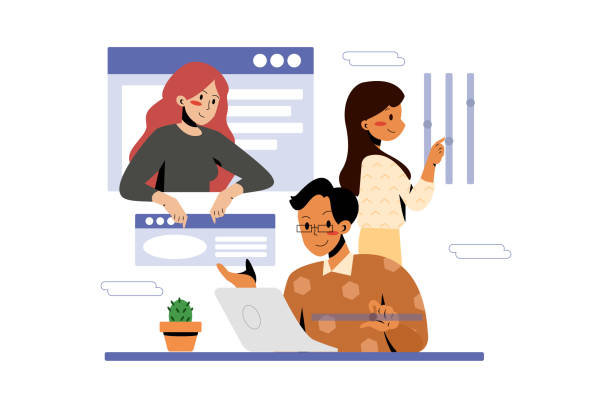Introduction to Modern User Interface Website Design

In today’s digital world, the first impression of a website can determine its success or failure.
Modern user interface website design is no longer a luxury choice, but a vital necessity.
#Modern_UI_Design goes beyond mere aesthetics, meaning the creation of a seamless, intuitive, and pleasant experience for the user.
This approach emphasizes simplicity, user-friendliness, and efficiency, so that users can easily interact with the website and achieve their goals.
Websites that suffer from old and complex user interfaces often lose their visitors, as today’s users have high expectations for ease of use and visual appeal.
A modern design not only makes your website look professional but also significantly helps improve #User_Experience and ultimately increase conversion rates.
This is especially crucial for businesses looking to attract and retain online customers.
This explanatory and educational section helps you gain a deeper understanding of the importance and necessity of modern UI design in today’s websites and why investing in this area is considered a strategic decision for any business.
Further in this article, we will delve into various aspects of user interface design, its principles and techniques, as well as the challenges and opportunities that exist on this path.
The ultimate goal is to create a website that not only meets user needs but also delights them and remains memorable in their minds, as a #modern_and_user-friendly_website is the key to success in today’s competitive landscape.
Did you know that 94% of users’ first impressions of a business are related to its website design? With professional corporate website design by **RasaWeb**, turn this first impression into an opportunity for growth.
✅ Attract more customers and increase sales
✅ Build credibility and trust in the audience’s view⚡ Get a free website design consultation!
Key Principles in Visual User Interface Design

To achieve successful UI design, adhering to specific principles and fundamentals is essential.
These principles not only contribute to visual appeal but also ensure the user-friendliness and efficiency of the website.
One of the most important of these principles is #simplicity.
A user interface should be as simple as possible and free of unnecessary elements so that the user can easily find their way and not get confused.
In fact, eliminating any unnecessary complexity helps guide the user towards performing the desired operations.
The second principle is consistency and uniformity (Consistency).
Visual elements, fonts, colors, and interaction methods must be consistent across all website pages.
This uniformity ensures that users become familiar with consistent patterns, making their navigation experience smoother and more predictable.
The principle of #Responsiveness is also of high importance.
Your website must display correctly on all devices, from desktops to tablets and mobiles, and provide a consistent user experience.
This means automatically adapting the layout and elements to the screen size.
Alongside these, #Accessibility is also a vital principle in modern UI design, meaning designing for all individuals, including users with disabilities.
These specialized principles form the foundation of any modern and effective user interface design, and adhering to them is essential for creating an unparalleled user experience and achieving business goals.
Advanced Tools and Technologies in Web Design Today

The world of web design is rapidly evolving, with new tools and technologies introduced daily to facilitate and improve the process of modern UI web design.
Choosing the right tool can significantly impact productivity and the final product’s quality.
In the field of User Interface and User Experience (UI/UX) design, tools like Figma, Adobe XD, and Sketch are highly popular.
These tools allow for rapid design and prototyping, enabling designers to quickly implement and test their ideas.
Figma, in particular, has revolutionized the design process with its real-time team collaboration capabilities.
In front-end development, frameworks like React, Vue.js, and Angular help developers build complex and interactive user interfaces with less coding and greater efficiency.
These frameworks simplify the development process by providing reusable components and optimized state management.
Additionally, CSS libraries like Bootstrap and Tailwind CSS significantly help accelerate the styling process and ensure website responsiveness across various devices.
Awareness of these #design_tools and modern #front-end_frameworks is essential for any designer and developer looking to create outstanding user experiences.
This educational and specialized section introduces these tools and provides guidance on choosing the best tool suited to your project needs.
Comparison of User Interface Design Tools
| Tool Name | Advantages | Suitable For |
|---|---|---|
| Figma | Real-time team collaboration, browser-based, powerful plugins | Large teams, collaborative projects, startups |
| Adobe XD | Integration with Adobe products, strong prototyping, animation features | Designers experienced with Adobe, projects with high animation needs |
| Sketch | Numerous plugins, large user community, macOS exclusive | Independent UI/UX designers, small teams, macOS users |
Synergy of User Interface and User Experience in Web

User Interface (UI) and User Experience (UX) are two inseparable concepts in web design that complement each other in practice.
While User Interface (UI) deals with the appearance and visual elements of a website, User Experience (UX) focuses on the overall feelings and interaction of the user with that product.
A website design with a modern UI can never succeed without a strong User Experience.
In other words, a website might look beautiful (good UI), but if the user cannot easily interact with it or achieve their goal, its User Experience (UX) will be poor.
To create an excellent user experience, conducting initial #user_research, including interviews, surveys, and competitor analysis, is essential.
These researches help designers identify the needs, behaviors, and expectations of target users.
Subsequently, creating user personas, Customer Journey Maps, and Wireframes helps organize and prioritize information.
#User_Testing at various stages of design is also of high importance.
By observing users interacting with the website, designers can identify weaknesses and address them.
This analytical and iterative process ensures that the modern user interface is not only visually appealing but also provides a smooth, logical, and enjoyable user experience.
Ultimately, designing a website with a modern user interface must simultaneously consider aesthetics and functionality so that users can effectively and efficiently achieve their goals and enjoy their presence on the website.
It is this synergy between UI and UX that leads to the ultimate success of a digital product.
Don’t have a corporate website yet and missing out on online opportunities? With professional corporate website design by RasaWeb,
✅ Double your business credibility
✅ Attract new customers
⚡ Free consultation for your corporate website!
Emerging and Future-Defining Trends in Web Design

The world of web design is constantly changing, with new trends emerging on the horizon that influence how we interact with the internet.
Understanding these #web_design_trends is crucial for anyone looking to create a modern and cutting-edge user interface design.
One of these trends is the widespread use of Dark Mode, which is not only beneficial for reducing eye strain in low-light environments but can also give a website a distinct visual appeal.
Another trend is the increasing importance of Micro-interactions; small animations and feedbacks that improve the user experience and make the website more lively and dynamic.
With the emergence of new technologies, Voice User Interfaces (Voice UI) and the use of Artificial Intelligence in design (AI-driven Design) are also growing.
Voice UI allows users to interact with websites using voice commands, which is particularly useful for accessibility and convenience.
AI can also be employed in personalizing the user experience, optimizing layouts, and even automating parts of the design process.
This news and analytical section examines these emerging trends and how they impact the future of modern UI website design, providing thought-provoking information on how to prepare yourself for these changes.
Following these trends helps you stay one step ahead and create websites that are not only contemporary but also remain sustainable and appealing for the future.
Challenges and Solutions for Responsive Website Design

Given the increasing diversity of devices, from small smartphones to wide monitors, #Responsive_Design has become a cornerstone of modern UI website design.
The main challenge here is ensuring that your website displays correctly and provides a consistent user experience on every screen size.
This means automatically adjusting the layout, images, and text according to the device dimensions.
One of the most common approaches to solving this challenge is the #Mobile-First approach.
In this method, design begins for the smallest screen (mobile) and then gradually expands for larger screens (tablet and desktop).
This approach helps designers focus on core content and functionality and avoid adding unnecessary elements that could cause issues on smaller devices.
Using relative units (such as percentages, em, rem) instead of fixed units (like pixels) for sizing elements, as well as leveraging Media Queries in CSS, are other key solutions in responsive design.
Furthermore, optimizing images for different devices (e.g., using the <picture> tag or srcset) and ensuring elements are clickable on touch screens are important points in this specialized and guidance-oriented process.
Ignoring responsive design can lead to a poor user experience and the loss of a large segment of the audience.
Therefore, every modern UI website design project must take these challenges seriously and implement appropriate solutions to ensure full compatibility across all devices.
Performance Optimization for Advanced UI Websites
![]()
Website loading speed not only affects user experience but is also considered a key factor in search engine rankings.
In modern UI website design, which often includes animations, high-quality images, and complex scripts, #speed_optimization is of particular importance.
A beautiful but slow website quickly loses its users.
There are various specialized solutions to improve #website_performance.
One of the most important is image optimization.
Using appropriate image formats (like WebP), compressing images without significant quality loss, and implementing Lazy Loading for images outside the initial viewport can make a significant difference in loading speed.
Reducing HTTP requests by combining CSS and JavaScript files, as well as minifying these files, are also effective methods.
Using Content Delivery Networks (CDNs) to deliver content from the nearest server to the user helps reduce latency.
In terms of coding, optimizing JavaScript and CSS code, eliminating unnecessary code (Tree Shaking), and using techniques like Code Splitting to load different parts of the website separately can lead to significant improvements.
This educational section explains these techniques and provides guidance for implementing them on your website.
Remember that a modern user interface must be optimized not only for aesthetics but also for performance to provide the best experience for users.
Website Performance Optimization Checklist
| Factor | Description | Status |
|---|---|---|
| Image Optimization | Compression, converting to WebP format, Lazy Loading | ✅ |
| CSS/JS Compression | Minification and Concatenation of files | ✅ |
| Use of CDN | Content delivery from the nearest server | ✅ |
| Browser Caching | Settings for storing static content in the user’s browser | ✅ |
| Reduce HTTP Requests | Reducing the number of loaded files and resources | ✅ |
Integrating Accessibility into Inclusive Web Design

Web Accessibility means designing and developing websites in a way that people with disabilities can also easily use them.
This is no longer a luxury option but an ethical and legal necessity, especially in website design with a modern approach that aims for inclusivity for all users.
Ignoring #accessibility can lead to losing a large portion of the audience and even result in legal issues.
For example, blind or visually impaired users use Screen Readers to understand website content.
Ensuring that images have appropriate Alt Text, that the HTML structure is Semantic HTML, and that keyboard navigation is possible, are fundamental principles.
Deaf or hard-of-hearing users require captions and transcripts for video and audio content.
For users with motor disabilities, ensuring that interactive elements are large enough and do not require excessive mouse precision is important.
Also, Web Content Accessibility Guidelines (WCAG) are international standards that help designers and developers build their websites in accordance with the principles of #inclusive_design.
This explanatory and guidance section discusses the importance of accessibility, its challenges, and practical solutions for implementing it on your website.
By integrating accessibility from the outset of the design process, you not only provide better services to all users but also enhance your brand’s credibility and value.
Does your current e-commerce website design not generate the sales you expect?
RasaWeb specializes in professional e-commerce website design!
✅ An attractive and user-friendly website aimed at increasing sales
✅ High speed and security for an ideal shopping experience⚡ Get a free online store design consultation with RasaWeb!
Lessons from Successful Modern Web Design Examples

To deeply understand the principles of up-to-date UI website design, nothing beats examining real and successful examples.
Many leading websites worldwide have provided unparalleled user experiences for their audiences by creatively and effectively implementing modern UI principles.
Examining these successful #case_studies can teach us valuable lessons.
For example, websites like Airbnb or Stripe are renowned for their stunning simplicity, intelligent use of white space, and intuitive and smooth navigation.
These websites demonstrate how to create maximum efficiency and appeal with minimal elements.
Another, like Apple, conveys a sense of luxury and innovation to the user by emphasizing high-quality images, readable fonts, and subtle yet functional animations.
Large news media websites like The New York Times, with their flexible layouts and personalization capabilities, are examples of providing rich content with an organized user experience.
These examples prove that a #successful_website is not only beautiful but also functionally flawless and effectively meets the specific needs of its users.
Analyzing these websites shows how one can achieve a distinct web design by focusing on details, UI/UX synergy, and implementing current trends.
This engaging and analytical section makes you wonder how you can learn from the best in the industry and apply these lessons in your projects to achieve a truly modern and inspiring user interface design.
Conclusion and the Path Forward for Web Designers

Throughout this article, we explored various dimensions of modern UI website design; from introducing key principles and advanced tools to the importance of user experience, future trends, challenges of responsive design, and performance optimization.
We also emphasized the importance of accessibility and the lessons that can be learned from successful examples.
What is clear is that web design today is no longer just about making a website look beautiful, but about creating meaningful and user-centric digital experiences.
For web designers, this path is a continuous journey of #continuous_learning and adapting to changes.
Technologies and user expectations are constantly evolving, and a successful designer must always stay updated and upgrade their skills.
Studying specialized articles, participating in workshops, following prominent designers and experts on social media and design platforms, and most importantly, continuous practice and undertaking practical projects, are key to success in this field.
The future of web design promises smarter, more personalized, and more inclusive user interfaces.
This concluding and guiding section helps you gain a comprehensive overview of what you’ve learned and take your next steps toward becoming a successful web designer.
Remember that every website you design is an opportunity to create a positive and lasting impact on users.
By following the principles and techniques provided, you can create websites that not only meet technical requirements but also establish a deep connection with your audience and ultimately contribute significantly to the success of your projects.
#The_future_of_web_design is in your hands.
Frequently Asked Questions
| Question | Answer |
|---|---|
| What is modern user interface? | Modern user interface refers to a design that utilizes new trends, simplicity, excellent user experience, and appealing visual elements. |
| Why is using a modern user interface important in website design? | It helps attract and retain more users, creates a professional impression, improves user experience, and increases conversion rates. |
| What are the main features of a modern user interface? | Simplicity, ample use of white space, readable typography, attractive and harmonious colors, subtle animations, and responsive design. |
| How is responsiveness related to modern user interface? | Responsive design is an essential feature in modern UI that ensures the website displays well on all devices (mobile, tablet, desktop). |
| What is the role of typography in modern user interface design? | Choosing appropriate fonts and using them correctly increases readability and contributes to the website’s visual appeal and brand identity. |
| What is White Space and why is it important in modern UI? | It is the empty space between different elements on a page, which helps improve readability, user focus, and creates a sense of cleanliness and order. |
| What is the benefit of using animations in modern user interface design? | Subtle and purposeful animations can attract user attention, improve interaction, and make information transfer more engaging. |
| How can User Experience (UX) be improved alongside a modern user interface? | By understanding user needs, simplifying navigation paths, providing appropriate visual feedback, and easy testability. |
| Does modern user interface always mean using bright colors? | No, modern user interface can use a variety of color palettes, including dark colors; the important thing is choosing harmonious colors suitable for the brand. |
| What are the current trends in modern user interface design? | Use of Dark Mode, Neumorphism, Glassmorphism, scroll-based animations, and minimalist design. |
And other advertising services of RasaWeb Advertising Agency
Smart Content Strategy: A new service for improving SEO ranking through the use of real data.
Smart UI/UX: A dedicated service for increasing click-through rates based on user experience customization.
Smart Google Ads: A professional solution for improving SEO ranking with a focus on optimizing key pages.
Smart Advertorials: A professional solution for customer acquisition with a focus on precise audience targeting.
Smart SEO: A dedicated service for growth in customer behavior analysis based on intelligent data analysis.
And over hundreds of other services in the field of internet advertising, advertising consultation, and organizational solutions
Internet Advertising | Advertising Strategy | Advertorials
References
What is UI/UX Design?Modern User Interface Design GuideWeb Design Trends in 2023How to Design a Responsive Website?
? Transform your business in the online world with Rasaweb Afarin Digital Marketing Agency; from fast website design to comprehensive SEO strategies.
📍 Tehran, Mirdamad Street, next to Bank Markazi, Kazerun Jonoubi Alley, Ramin Alley, No. 6




